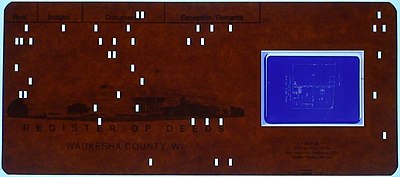To begin our journey into the diverse realm of microform in
library collections, we will first define microform and the types of microform
commonly used.
Microphotography, also termed microform or more commonly
referred to by its most common permutation microfilm, is almost as old as photography
itself. The first microphotographs were produced by John Benjamin Dancer in 1839.
Drawing on Daguerre and Fox Talbot’s photographic methods as well as the work
of other scientists, artists, and inventors, Dancer eventually perfected the
process (“Dancer, John Benjamin” 2016). However, it would not be until much
later, practically the term of the century, that the process would become a
staple in records and preservation communities on the global scale. A more
detailed history and expose on Dancer and other individuals of significance to
the development of microphotography will be discussed in the next posting "Pioneer
Scientists and the Early History of Reprography."
Example of an Aperture Card from https://upload.wikimedia.org/wikipedia/commons/thumb/7/77/Aperture_card.JPG/400px-Aperture_card.JPG
Photo of New York Times Index, 1874-1883 microfilm reel located in The University of Southern Mississippi Cook Library microform collection
Microform is commonly defined as the generic media on which
text or images are reproduced in a drastically reduced state using
microphotographic processes (“Microform” 2016). The two most commonly discussed
examples of microform are microfilm and microfiche; however, other types of
microform include aperture cards and microcards. Microfilm is very similar in
form to 35mm camera film while microfiche resembles a small overhead projector
transparency sheet. Microfilm is often cited as having low-reproduction and
storage cost alongside space-saving attributes; however, it does require
special readers in order to properly few the material.
Photo of School Library Journal, Sept 1978, Volume 25, Issue 1 microfiche located in The University of Southern Mississippi Cook Library microform collection
Altered Detail of Above
In the library world, around the 1930s, microform techniques
became particularly important for the storage of fragile documents that would
not necessarily be able to stand the test of time such as aging newspaper
collections or books made with heavily acidic paper. The year 1938 saw the
founding of University
Microfilms, Inc., now a part of ProQuest (see history of corporation here), and the beginnings of Harvard
University Library’s Foreign Newspaper Project (Heritage Archives 2015). Looking
to more contemporary examples example, The Library of Hattiesburg, Petal, and
Forrest County is the primary repository for the local newspaper The
Hattiesburg American. This paper continues to be microfilmed and stored at the
Library to this day even though a significant portion of the paper is now
available digitally through the Newspaper Archive database. The National
Archives and Records Administration (NARA) is still using microfilm for the
purpose of preservation and storage, citing microfilm as a “low-cost, reliable,
long-term, standardized image storage medium” (NARA 2016).
This project regarding the evolution of microforms in the
library setting is continued in six other postings.
- Pioneer Scientists and the Early History of Reprography
- Image Creation and Duplication in Microform Processes
- The Rise (and Decline?) of Microform Use in Libraries
- Advantages and Disadvantages of Using Microform
- Preservation Strategies and Microforming
- Current and Potential Trends in the World of Microphotography
Bibliography
Dancer, John Benjamin. (2016). In The Hutchinson Unabridged
Encyclopedia with Atlas and Weather Guide online. Retrieved from http://lynx.lib.usm.edu/login?url=http://search.credoreference.com/content/entry/heliconhe/dancer_john_benjamin/0.
National Archives and Records Administration [NARA]. (2016).
Microfilm. Retrieved from https://www.archives.gov/preservation/formats/microfilming.html.
Microform. (2016). In The Hutchinson unabridged encyclopedia
with atlas and weather guide online. Retrieved from http://lynx.lib.usm.edu/login?url=http://search.credoreference.com/content/entry/heliconhe/microform/0.
Heritage Archives. (2015). Brief History of Microfilm. Retrieved
from http://heritagearchives.org/history.html.




No comments:
Post a Comment